Our trip to Arizona was split almost equally among Tucson, Phoenix and Sedona. It was our first “real” trip out there other than a handful of days across the years on quick in-and-outs to Phoenix. We LOVED it and can see ourselves returning again and again.
Best of all, there is so much to do for free. In fact, most of our activities turned out to be free. 10 free activities that are highly recommended:
- Driving around Mount Lemmon and Tucson Mountain Park in Tucson
- Garden of Gethsemane sculpture in Tucson
- Casa Grande Ruins between Tucson and Phoenix
- Phoenix Desert Botanical Garden (free on 2nd Tuesday of each month)
- Phoenix Art Museum (free on Wednesdays, after 3p)
- Papago Park in Phoenix
- Mesa Community College Rose Garden
- Jerome Artists Cooperative in Jerome, near Sedona
- Chapel of the Holy Cross, near Sedona
- Amitahba Stupa in Sedona
Tucson – running, walking, Bollywood
We flew in and out of Phoenix, but our first stay was Tucson as Scott ran the Tucson marathon (knocking off yet another state on his quest to run a marathon in all 50 US states). We arrived late on Thursday and just stayed at a hotel near the airport.
Friday was all about settling into Tucson, attending the marathon expo and a big Italian dinner in preparation for the Saturday marathon. The marathon wasn’t free, but we track running expenses separate from travel, even though we almost always build a trip around Scott’s marathons.
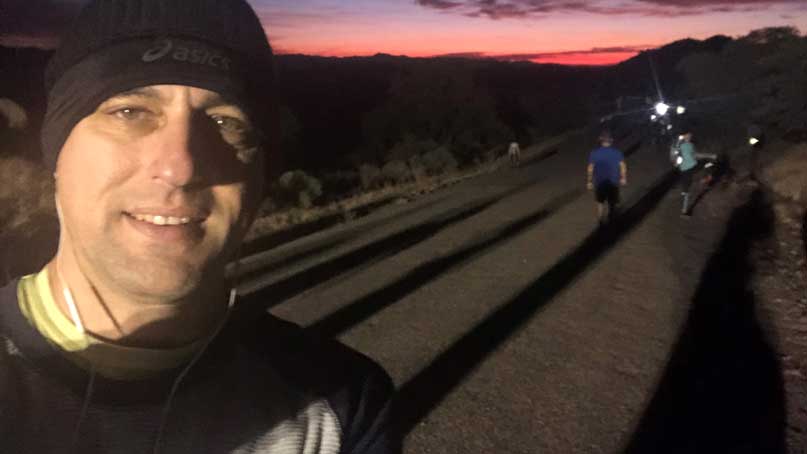
Sunday was Day 4 of our trip, but really our first proper day of vacation. We spent it outdoors, walking around historic Fourth Avenue with its independent bookstore, vintage shops and cafes (of course, we tried the gourmet donut shop). One of the local establishments was a dance and exercise studio, Floor Polish, where I took a Bollywood class! At $7 for a single class, it wasn’t free but still a bargain.
Driving around Tucson Mountain Park was scenic and free. We passed it on our way to the Saguaro National Park. Saguaro National Park costs $20 for a weeklong pass, or $80 for an annual pass to all US National Parks, as well as other sites (monuments, historic sites, etc.) operated by the National Parks Service.
As we intend to travel extensively in the next few years, we opted for an annual pass. $80 was our largest excursion expense, but since it will be amortized over the next year, it’s still a bargain. (As it turned out, we had occasion to use the pass two more times in Arizona alone).
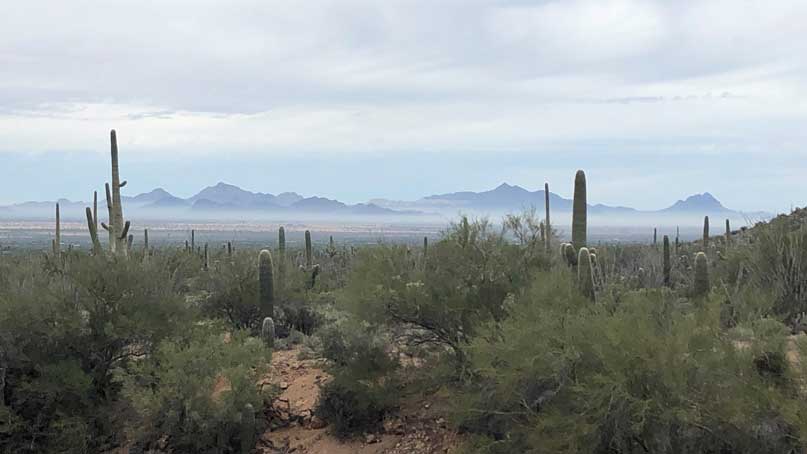
We also drove up Mt Lemmon in the Santa Catalina mountains. It is just outside Tucson, but fascinating because you start the drive in the Arizona desert looking at cacti, but within 30 minutes, you ascend to 8000 feet above sea level and you find yourself in pine forests! There is skiing at the top of the mountain in wintertime, and we did see some snow up there.
The town at the top of the mountain is called Summerhaven, and has a couple of shops to look at, and a delicious, albeit pricey (understandable given the remote location), cookie place called Mt Lemmon Cookie Cabin. We opted for the sampler cookie, which was a giant cookie, made of small pieces of each of their other six cookies. It was cold up there, so we also had the hot apple cider, which hit the spot!

Sculpture and archaeology on the way out of Tucson
Day 5, we left Tucson but did a quick stop at the Garden of Gethsemane sculpture garden. This park features life-size statues of the Last Supper and other religious scenes by sculptor Felix Lucero. It takes just a few minutes to go around the sculptures and is free to enter. It was cold and wet the day we visited, but on a warmer, sunnier day, it would be a nice option for prayer and reflection.
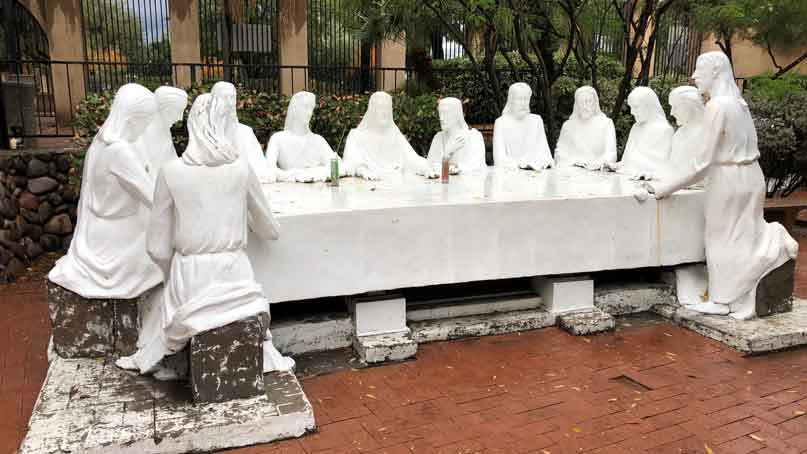
We then drove from Tucson to Phoenix and visited Casa Grande Ruins in-between. The Ruins are 650-year old structures in national monument site that is free to visit and is a significant landmark in Native American history. There is a 10-minute film and guided tours throughout the day, so you learn a lot about the site and its significance. The site often hosts craft events, and there was a Hopi jewelry maker on the day we first visited (of course, I bought something).

On our way, after driving through a rainstorm, we even saw a full rainbow…
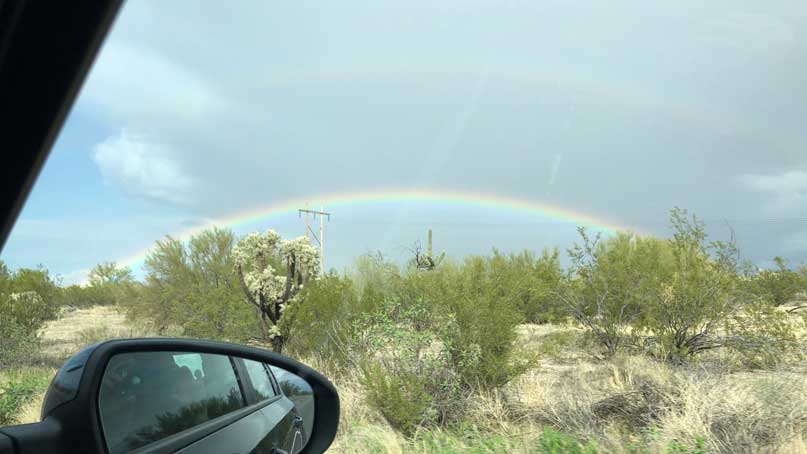
Phoenix – 3 gardens, 2 sunsets, 1 Sugar Bowl
Day 6, our first full day in Phoenix, we visited the Desert Botanical Garden, which normally costs $25-30 per ticket, but is free the second Tuesday of each month, when we luckily happened to be there! Desert flora is one of my favorite landscapes, and this garden did not disappoint! We know so much about cacti now. We already knew about the saguaro cactus from our Tucson days:
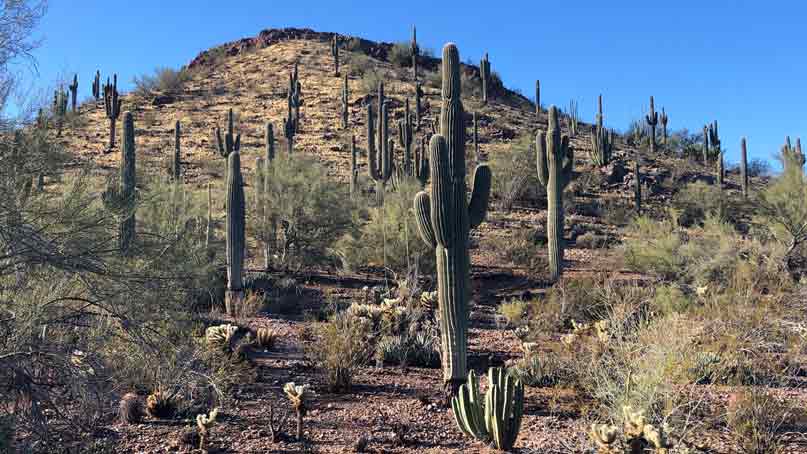
But we got up close with the prickly pear variety:

The cholla:
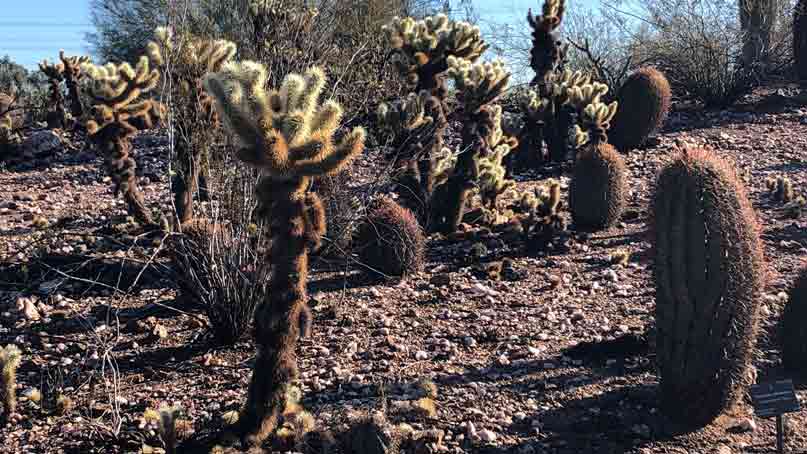
The organ pipe:
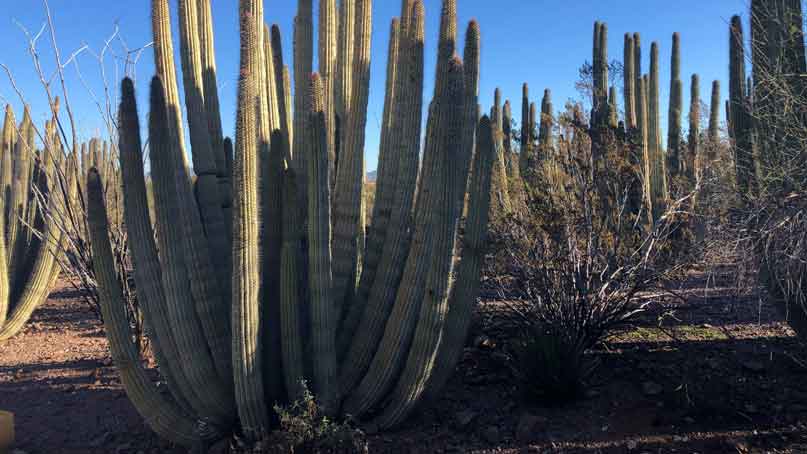
We unfortunately didn’t get any photos of the totem pole cactus!
The next day, we saw two sites — first up, Pueblo Grande, a Native American site similar to the Casa Grande Ruins but in the heart of Phoenix. This cost $12, and I would pass on this over the Casa Grande Ruins, which are just about an hour away. However, we were happy to support the site and got a tip from the reception desk that the Phoenix Art Museum was free after 3p! That tip was worth far more than $12.
In-between sightseeing, we stopped at The Sugar Bowl, an old-fashioned ice cream parlor that is decorated in pink and featured in the Family Circus comic strip. I am a big fan of Family Circus, the color pink and ice cream, so this was a real treat and a place we’d definitely return to. I highly recommend the custom banana split. Ours had almond praline and rocky road ice creams, hot fudge and peanut butter sauces and almonds – DELISH!
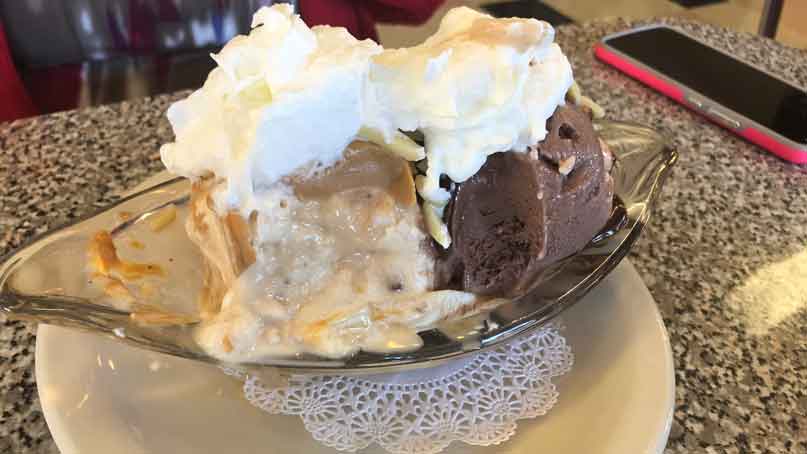
The Phoenix Art Museum is big but accessible. We saw less than half of it in the two hours we dedicated, but we took our time meandering from gallery to gallery. My favorite piece was Black Resin, a sculpture by Anish Kapoor. However, there is a wide variety of art and something for everyone – traditional to modern, different media, newer artists and household names like Rodin, Warhol, Monet and Chagall. The museum is free every Wednesday after 3p, so it is an excellent stop on your Phoenix trip.
Same evening, we caught a spectacular sunset and moonrise at Papago Park. The park is free to enter. You can hike up to the Hole In The Rock, which is quite literally a rock with a giant hole. I am not a hiker, and there were lots of people already in the hole to catch the sunset, so we opted just for one of the many elevated points in the park and got a perfect view of the sunset to the west and then the moon rising out of the mountains on the east!
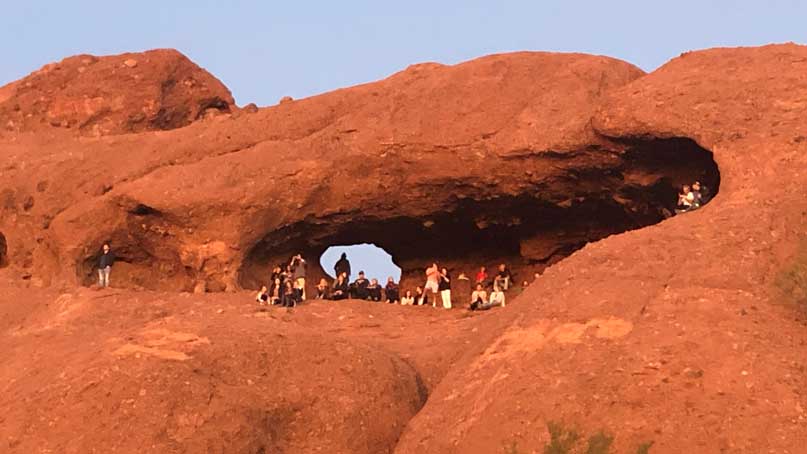
Day 7 was another free day of sightseeing, but somewhat of a letdown as we went to Roosevelt Row and The Hive, two spots recommended on various “top lists” of things to see in Phoenix. Both sites are supposed to be creative hubs for galleries, foodie restaurants and other artistic points of interest. However, The Hive was closed, even though we stopped by around 11am, and it supposedly opened at 7am. Roosevelt Row was also pretty dead and very spread out – not a walkable creative hub like Fourth Avenue in Tucson. Technically we entertained ourselves for free, but it wasn’t very entertaining.
The evening proved more successful as we returned to the Casa Grande Ruins for a special sunset viewing. The site is usually closed by 5p but they kept the grounds open till 7p, and we were treated to some of the most amazing colors in the sky.
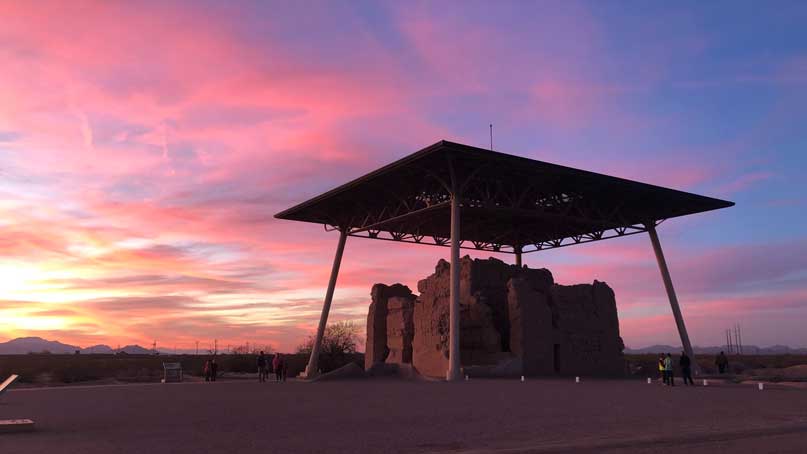
On our way out of Casa Grande Ruins, we caught another impressive moonrise. The best sites truly are free!
Day 8, we headed out to Sedona, but stopped at two rose gardens along the way, both free! The Phoenix Rose Society has a small garden open to the public, which takes just a few minutes to stroll through. If you’re in the neighborhood, by all means check it out.
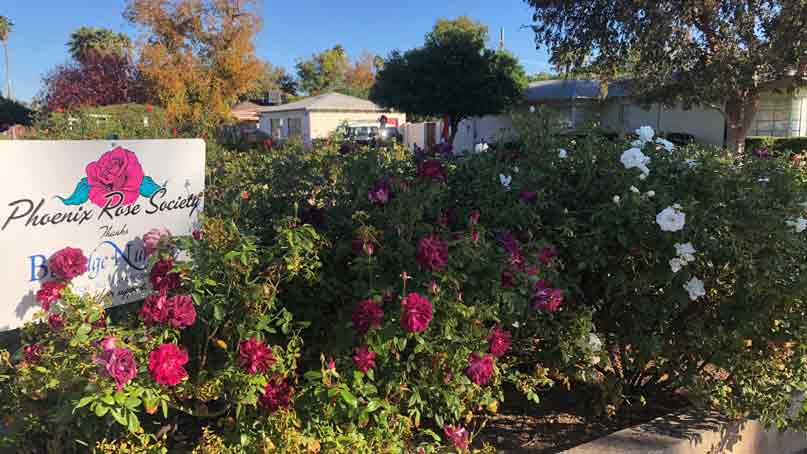
The Rose Garden at Mesa Community College boasts 9,000 roses! There is also an audio tour you can call into, which was very informative – it’s not always easy to find what stop number you’re on but when you do see a sign it’s worth calling into. We learned why Julia Child picked the yellow breed of rose to be named after her (it reminded her of butter) and that the Marilyn Monroe rose has lots of thorns. This was a very fun way to end our time in Phoenix.
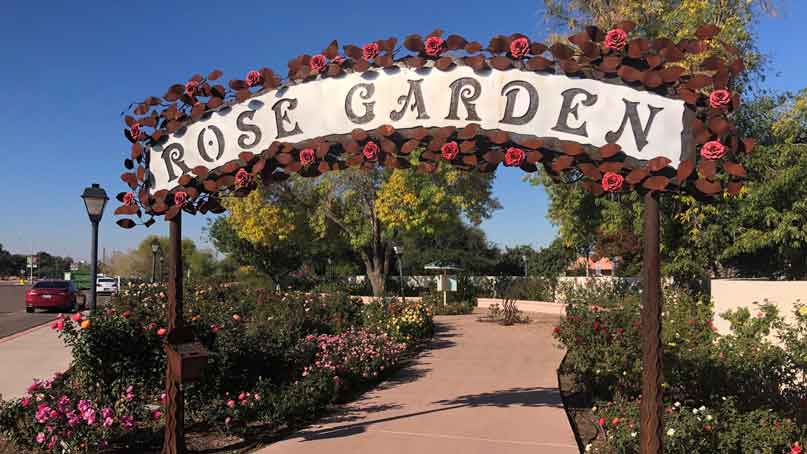
Sedona –commercial and natural splendor
After the rose gardens, we headed to Sedona. Our Phoenix AirBNB host recommended two small towns near Sedona – Jerome and Prescott – so we opted to stop at Jerome along the way. We spent a couple of hours in Jerome, a very walkable, artistic town that has similar earthy, spiritual, and crafty offerings as in Sedona, but at a more accessible price point and less crowded venue.
The Jerome Artists Cooperative is a large space featuring dozens of local artists. It’s beautiful to walk around – there are benches to rest that have spectacular mountain views. The staff is unpretentious and not at all salesy. There are also many smaller shops, including a gallery named Pura Vida by its Costa Rica-loving owners! We easily spent an afternoon wandering around Jerome, Scott enjoying the scenery and I enjoying the shops, and it was all free (except for the things I inevitably bought).

Day 9, we spent in Sedona proper, and the landscape is as spectacular as you’ve heard. Our first stop was the Chapel of the Holy Cross, a Catholic chapel built in the mountains, where the large outside cross is visible miles away jutting out of the mountains. It is free to enter (though a $5 donation lights a candle for 3 days), and you do not have to be Catholic to appreciate the artistry and splendor of the chapel. If you are Catholic, there is a well-stocked gift shop downstairs.
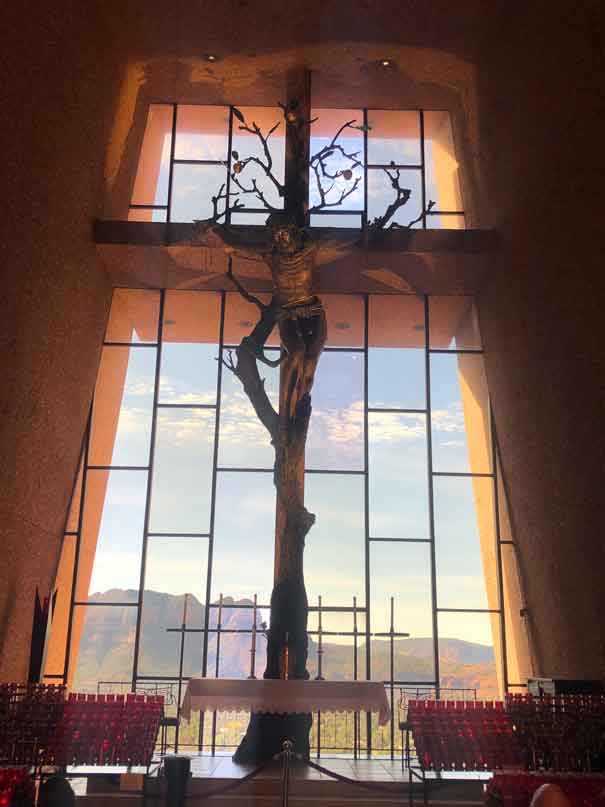
We then walked the Amitabha Stupa and Peace Park, free to enter (they accept donations) and a must-see. It truly is a peace park with its large Buddhist stupa, prayer wheels, a large medicine wheel, a Buddha statue and easy trails, taking you around the different sites. There are instruction signs along the way so you can easily participate or just learn about the different stations. There are excellent views, including Chimney Rock, along the trails.
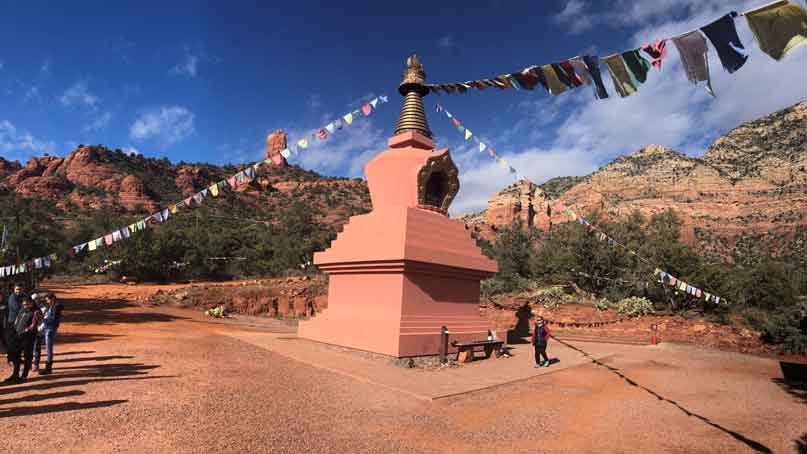
We then went commercial and hit the Tlaquepaque Arts & Shopping Village, the bustling shopping hub of Sedona. It was the annual Festival of Lights, where they adorn the streets with paper bag lanterns that are lit simultaneously. We arrived early to get parking (still free!) but we actually left well before the lighting ceremony. It wasn’t as crowded as New York City gets (on even a regular day) but it was still too crowded for the otherwise peaceful vibe of Sedona.
Instead, we went to the Red Rock park area and attempted the Bell Rock Climb. There is a $5 fee to park in the Red Rock area, though we didn’t pay because we had a pass from our AirBNB host, and also could have used the National Parks annual pass we had purchased in Tucson.
I am clumsy and a scaredy-cat – two qualities that do not a good hiker make — so I didn’t get all the way up (I was passed by toddlers, old people, even a mom with a baby on a sling and 3 small kids in tow). It gets more difficult towards the very top (so I’ve heard) but we made it about halfway, and it was a spectacular view. Scott continued a couple of levels past me and had a fun climb. Though one shouldn’t hike alone, I figured that if Scott got in trouble, I could send one of the 4-year olds passing me up the platform where I was waiting!
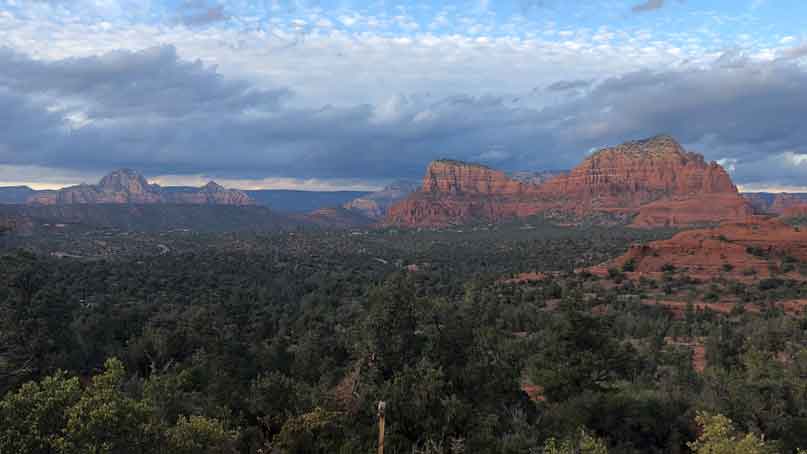
Day 10, we split our time between small towns, Jerome and Prescott. We hit Jerome again to see the Jerome State Park. As it’s state-run and not national, we were unable to use our parks pass, but entry fees were just $7 per person, or $14 for a nice walk of the grounds, an informative movie and a well-stocked museum on the history of Jerome (it was a big mining town and has a reputation for being haunted).
In the photo below, note the letter J etched in the mountain above Jerome. We saw that in a few places during our travels, and it is apparently a thing in Arizona, as well as throughout the western United States!
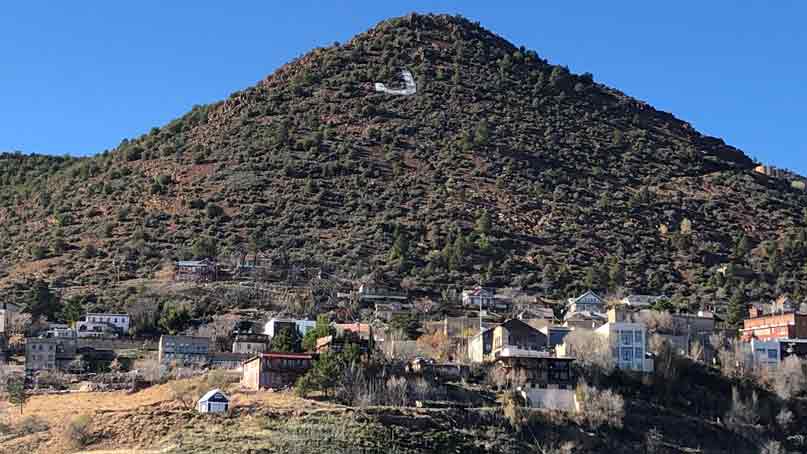
We then headed to Prescott, which has a historic downtown famous for its Whiskey Row and Antique Row. We were late into the trip, and I hadn’t yet gotten a gemstone I had promised our oldest, so the hunt was on. We hit several antique malls, and I collected some amber, carnelian and jasper pieces.
The Grand Canyon is as grand as its name
Day 11, our final day available for touring, we drove thru Flagstaff and to the Grand Canyon

It had snowed the day before, so the Grand Canyon was slippery and very cold. We didn’t stay long, but long enough to walk along the first few lookout points and catch two informative videos. Entry is $35 for a weeklong pass, but our parks pass got us in for free, so our initial $80 has already covered $55 in entry fees, and we still have a full year of use left.
The drive through Flagstaff was incredible.
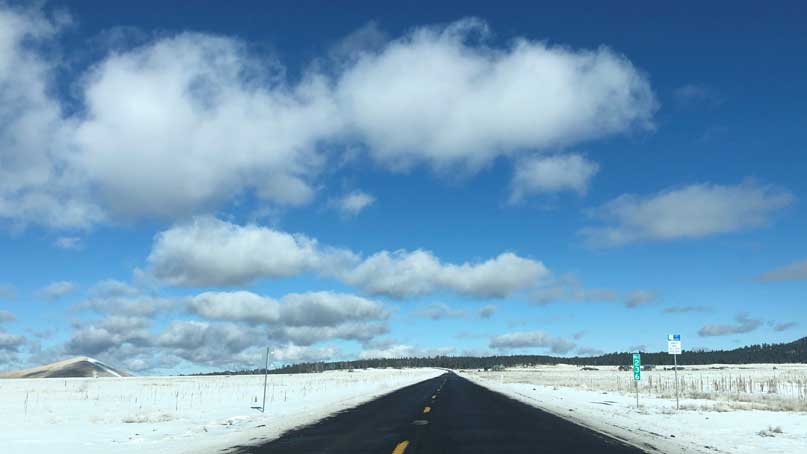
We stopped in Flagstaff to eat and walk around some galleries and shops. If it wasn’t so cold, we would have spent the evening at the Lowell Observatory, which came highly recommended by a local gallery owner. Next time! I was able to add a few more gemstones to my souvenir collection, picking up lapis lazuli and blue goldstone.
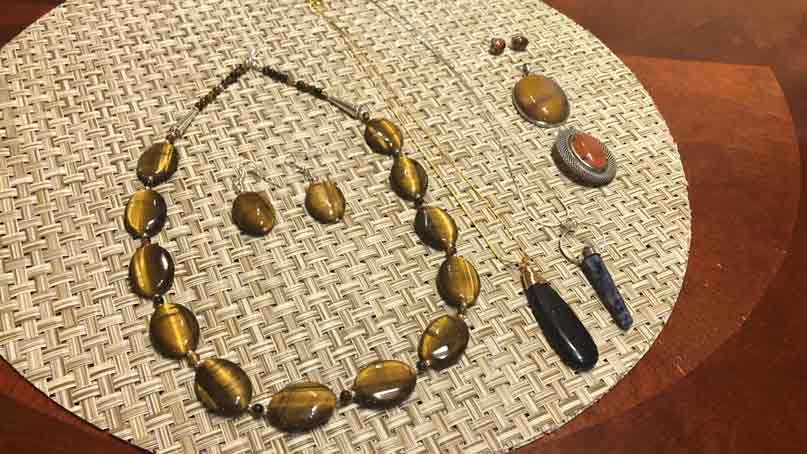
Arizona by the numbers
Entry fees for all the sites we visited totaled $118.50, and that includes the national parks pass which is good for all of 2020! We did do a lot of driving, and our transportation costs totaled just under $770. This figure did not include airfare, which we paid for in rewards points. However, the total does include our transfers to and from JFK airport in NYC, which is notoriously expensive and cost $228, or almost 30% of the total!
If we look at just the Arizona portion, our sightseeing cost ~$660 for 3 cities, the Grand Canyon, the Saguaro National Forest, the Red Rock area of Sedona, several gardens, several artistic points of interest, several museums and archaeological sites and many spectacular displays of nature.
More photos
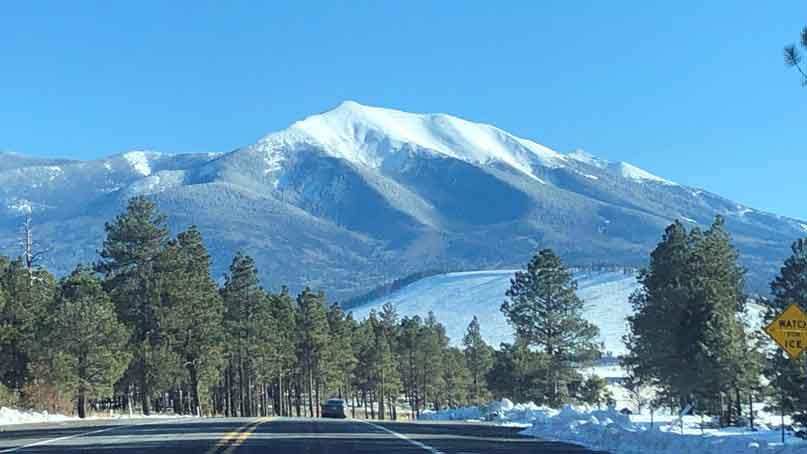
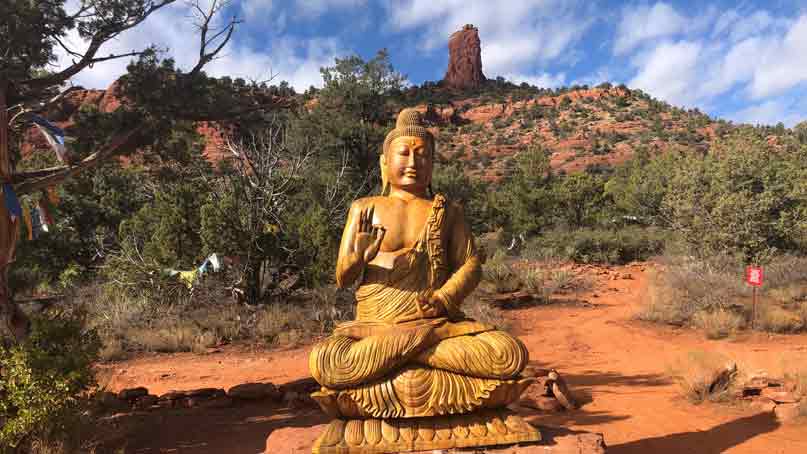
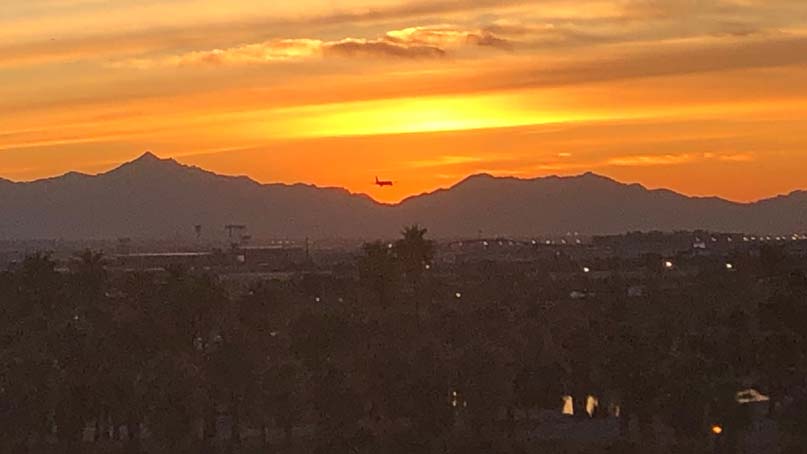
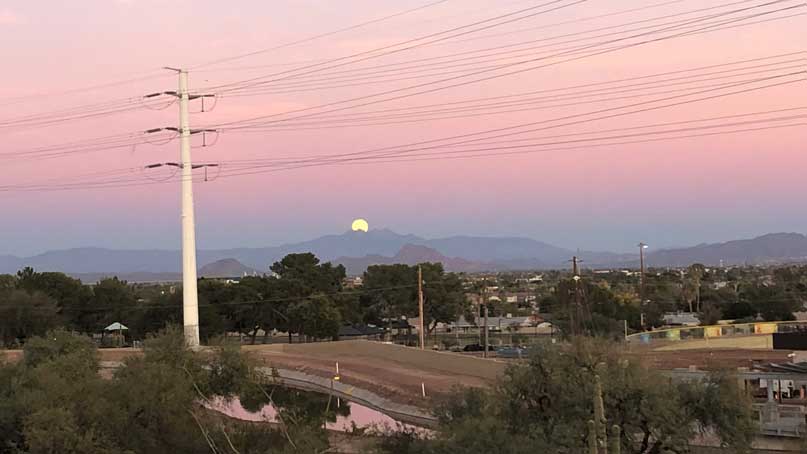
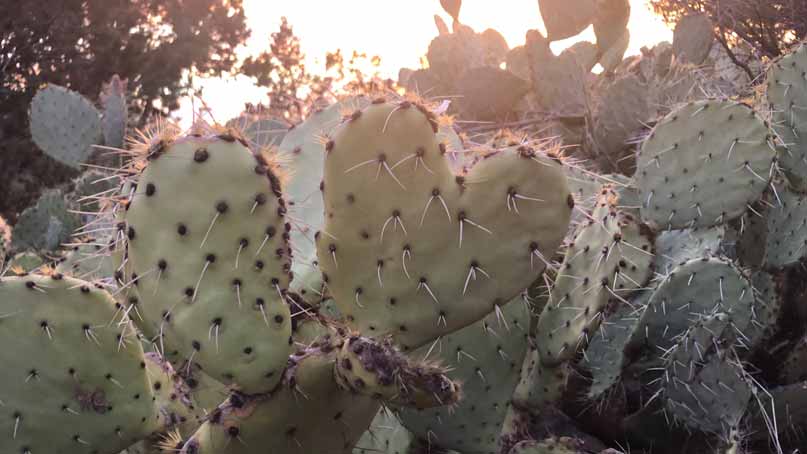
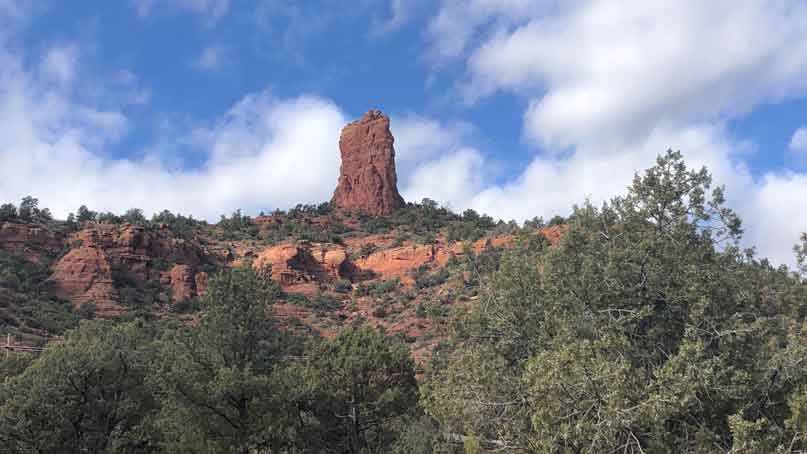
======
We can’t wait to go back, though our next trips are Costa Rica and the Philippines – two very different topographies and temperatures!
NOTE: Photo at the top is from one of the scenic roads in Saguaro National Park, outside of Tucscon

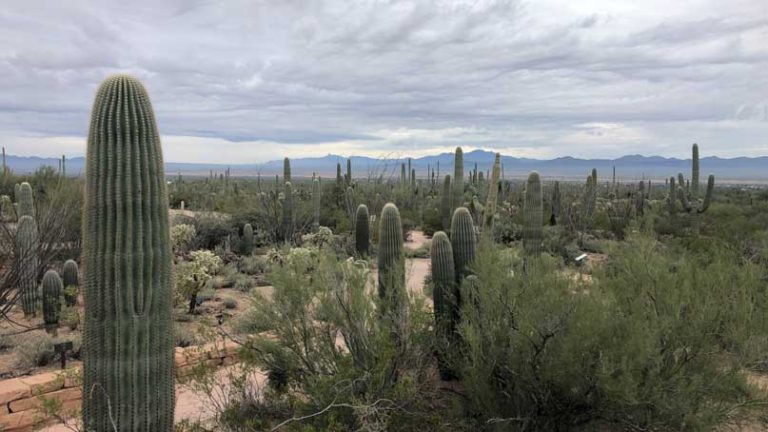
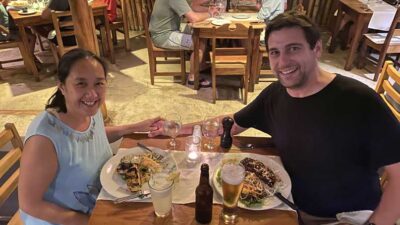 We are Scott and Caroline, 50-somethings who spent the first 20+ years of our adult lives in New York City, working traditional careers and raising 2 kids. We left full-time work in our mid-40’s for location-independent, part-time consulting projects and real estate investing, in order to create a more flexible and travel-centric lifestyle.
We are Scott and Caroline, 50-somethings who spent the first 20+ years of our adult lives in New York City, working traditional careers and raising 2 kids. We left full-time work in our mid-40’s for location-independent, part-time consulting projects and real estate investing, in order to create a more flexible and travel-centric lifestyle. 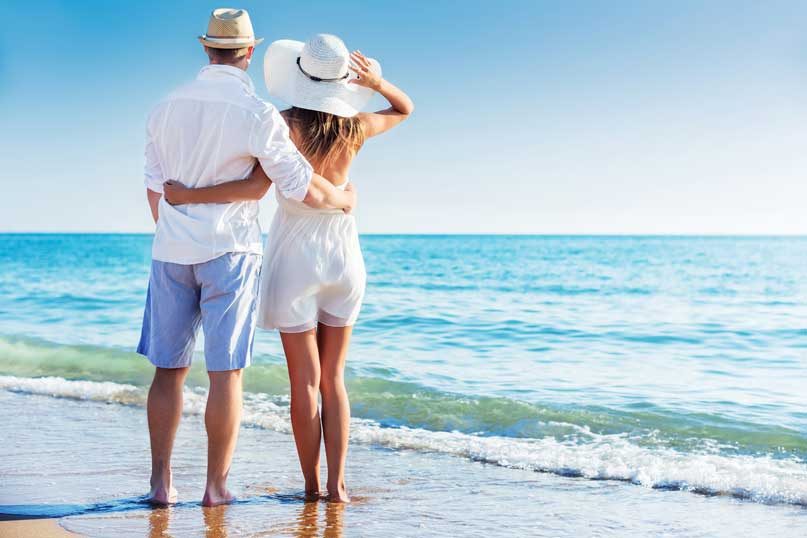 Financial independence and early retirement is not something we originally focused on, but over time realized it was possible. Our free report,
Financial independence and early retirement is not something we originally focused on, but over time realized it was possible. Our free report, 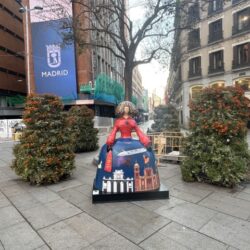
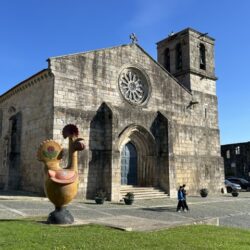
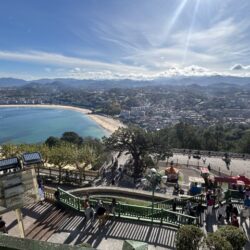


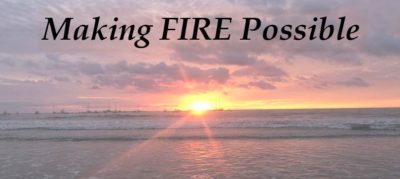
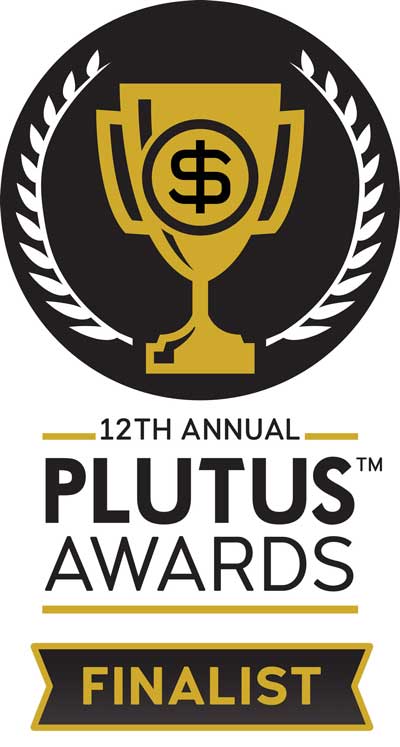

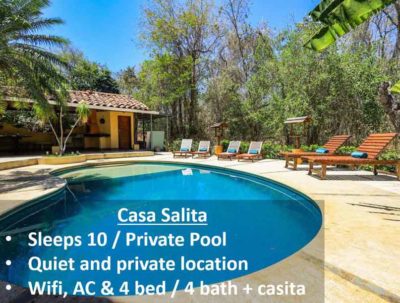
Loved reading about your trip in Arizona. That’s where I met my wife Val and we ended up getting married in Sedona. It was breathtaking. Jerome was awesome as well. I felt like it was super underrated. That old copper mining town has some awesome art and the people were awesome. My wife and I love to travel. You guys look like you have an awesome time. Great pics!
Jeff
Wow, I can’t even imagine how breathtaking a wedding in Sedona would be. Lucky! We got married on Long Island — which was fun but slightly less breathtaking:) We loved the small towns — Jerome, Prescott. We can’t wait to go back.